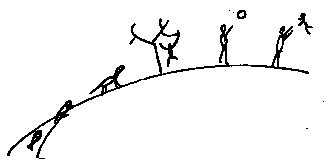|
Letter
to the editor
The ASCAP Bulletin Vol.2, No.2 April 2001
What
is a story?
Every
story has a beginning, a sort of action and an end. Let us start
with
short stories: A becomes B or A goes from B to C. In biology, more
precisely
in ethology, we call this type of short stories an episode or an
actugenetic
event.
A single eyeblink, the reaching for a food item or the journey some
birds do every year across thousands of miles are examples. Because
of the closure of the NS only seldom you can say when an action
starts or ends. Fuzzy temporal and anatomical borders are common
but identity of the performer is usually preserved; the eye, the
hand or the bird.
Good stories often offer more than one episode, more complexity
is
easily obtained by meshing one story within another story. The best
story-box is (the memory of) a human story-teller who everyone of
us is.
Let's look into our lifetime as a unique story with at least two
parts so far, from birth to reading these lines and from here to
where you go or what ever you do. But now please take serious the
proposition that every movement of our body is part of our personal
story-line which is the very line our body draws through space and
time.
After birth we are carried around above ground level, later we crawl
on it slowly on all four limbs, then the very first steps - the
line of that event is usually remembered in all details: starting
point Mama - three, four or six delicately balanced steps - endpoint
aunt Mary or - less often - Papa.
We can imagine the daily routes of walking, driving, shopping, visiting
any place inside the flat or anywhere in our home-town - and every
evening we arrive at the same point of return or rest: our bed (except
bachelors).
We move to another town, we fly into holiday or climb mountains
- in principle all movements we perform during our life time can
be seen as one line - drawn continuously by our center of gravity
(which can virtually represent the whole body in one point placed
somewhere near the stomach).
For our cognitive life we must take the labyrinth of the inner ear
as the very instrument to draw the life-line: It perceives every
acceleration in all directions, rotations in particular, and it
can judge distances of being carried (or even
being driven) quite precisely. The labyrinth is the first sense
to be alert in our lives (12th week of gestation) and probably is
also our last one working.
In short: The ceaseless chain of single behavioral episodes stored
in biographical memory makes a life-line. Actugenetic situations
are the micro-elements of ontogeny - and locomotion is the performing
part.
The story of all stories, as you know, is evolution and we are concerned
here with the phylogeny of vertebrates including ourselves.
Is it a story of success? - yes.
Is it also a story of "ascending" development?
A story of reaching higher levels: yes. Fish started below sea-level,
amphibians mounted the shores, mammals lifted their bodies from
ground and primates climbed the trees. Then there was a "down"
with hominids returning to the ground-level, but by lifting their
forelegs together with the front half of the body they started the
most impressive (and still unexplained) story of all, hominisation,
becoming human. Cooperation enabled them to reach the highest level
so far, the orbit of the moon:

Again we can say that evolution is the succession of innumerable
ontogenies, from the first paleozoic fish to everyone of us.
In this way evolution is a locomotor story.
|